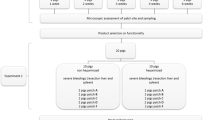Summary
The Fibrinogen Thrombin Adhesive System (FTAS) enables local haemostasis to occur in parenchymatous organs without tissue damage. The aim of this study was to investigate the degradation of FTAS and the process of wound healing after partial kidney resection in rats using FTAS for induction of local haemostasis.
In 28 rats partial kidney resection was performed bilaterally. Haemostasis was achieved with Fibronogen Thrombin Adhesive System. Four experimental groups were formed. Group A (n=3): Haemostasis with unlabelled FTAS, subcutaneous injection of 0.1 ml=60 μ Ci Na 125I. Group B (n=3): Haemostasis with unlabelled FTAS, subcutaneous injection of 0.1 ml=60 μ Ci 125I FTAS. Group C (n=6): Haemostasis with 125I labelled FTAS. Group D (n=16): treated like Group C. In Groups A-C 125I-elimination in 24 h urine samples was determined with a gamma-scintillation counter. Paris of animals in Group D were killed after 2, 6, 12 and 24 h and 3, 7, 14 and 21 days. Kidneys were examined under the light and electron microscope and by autoradiography. In animals of Groups B and C two peaks of 125I excretion were observed: one peak within the first 48 h postoperatively which corresponded to the amount of free iodine injected with FTAS (FTAS contains 15% free iodine); a second peak after 120 h which was most probably due to the degradation of FTAS. Fibrinolysis was not observed. FTAS was resorbed mainly by macrophages. The time course of wound healing paralleled that of physiological fibrinogen concentration. Renal parenchymal damage was not observed.
Similar content being viewed by others
References
Alkjaersig, N., Fletcher, A. P., Sherry, S.: The mechanism of clot dissolution by plasmin. Journal of Clinical Investigation 38, 1086 (1959)
Bösch, P., Braun, F., Eschberger, J., Kovac, W., Spängler, H. P.: The action of high-concentrated fibrin on one healing. Archiv für Orthopädie und Unfallchirurgie 89, 259 (1977)
Braun, F., Henning, K., Holle, J., Kovac, W., Rauchenwald, K., Spängler, H. P., Urlesberger, H.: A biological adhesive system (Fibrin) in partial kidney resection. Zentralblatt für Chirurgie 102, 1235 (1977)
Coover, H. W., Joyner, F. B., Shearer, N. H., Wicker, T. H.: Soc. Plast. Engl. J. 15, 413 (1959) cited at Beer, J., Theil, U.: Technik und bisherige klinische Ergebnisse des nahtlosen Wunderver-schlusses bei der menschlichen Niere. Zeitschrift für Urologie 5, 357 (1972)
Dudock de Wit, C., Krijinen, H. W., den Ottolander, G. J. H.: The measurement of fibrinolytic activity with J131-labelled clots I. The methods. Thrombosis and Haemostasis (Stuttgart) 8, 315 (1962)
Dudock de Wit, C., Krijinen, H. W., den Ottolander, G. J. H.: The measurement of fibrinolytic activity with J131-labelled clots II. Application. Thrombosis and Haemostasis (Stutgart) 8, 322 (1972)
Jennings, M. A., Florey, H. W.: Healing. In: General pathology. Florey, L. (ed.), Chapter 17, p. 480. Oxford: Lloyd-Luces 1970
Hunter, W. M., Greenwood, F. C.: Preparation J131-labelled human growth hormone of high specific activity. Nature (London) 194, 495 (1962)
Maunsbach, A. B.: The influence of different fixatives and fixation methods on the ultrastructure of rat kidney proximal tubule cells. I. Comparison of different perfusion fixation methods and of glutaraldehyde, formaldehyde and osmium tetroxide fixatives. Journal of Ultrastructure Research 15, 242 (1966)
Pflüger, H., Lunglmayr, G., Breitenecker, G.: Anastomosis of the vas deferens employing concentrated fibrinogen: An experimental study in rabbits. Wiener klinische Wochenschrift 88, 24, 800 (1976)
Rauchenwald, K., Henning, K., Urlesberger, H.: Kidney resection: Surgical technique and late results. Aktuelle Urologie 4, 169 (1973)
Rauchenwald, K., Urlesberger, H., Henning, K., Braun, F., Spängler, H. P., Holle, J.: Application of a fibrin adhesive for operations at the renal parenchyma. Aktuelle Urologie 7, 209 (1976)
Spängler, H. P.: Tissue adhesion and local haemostasis using fibrinogen, thrombin and clotting factor XIII. (Experimental investigation-Clinical experience). Wiener klinische Wochenschrift 88, Suppl. 49 (1976)
Truss, F., Thiel, K. H.: Experimentelle Ergebnisse des nahtlosen Nierenparenchymverschlusses. Urologe A, 4, 139 (1965)
Author information
Authors and Affiliations
Rights and permissions
About this article
Cite this article
Pflüger, H., Stackl, W., Kerjaschki, D. et al. Partial rat kidney resection using autologous Fibrinogen Thrombin Adhesive System. Urol. Res. 9, 105–110 (1981). https://doi.org/10.1007/BF00254403
Accepted:
Issue Date:
DOI: https://doi.org/10.1007/BF00254403




